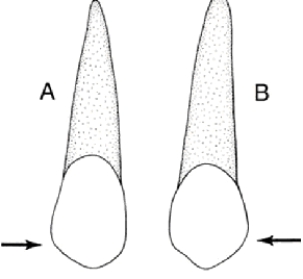B) False
Correct Answer

verified
Correct Answer
verified
Multiple Choice
Which statements correctly describe features of canines (Select all that apply. ) ?
A) The three facial lobes of the maxillary canine resemble the facial lobes of the incisors.
B) Maxillary canines frequently have one pulp horn and one root.
C) Mandibular canines have one pulp horn and can have one or two roots.
D) The cingulum is equally developed on maxillary and mandibular canines.
F) A) and B)
Correct Answer

verified
Correct Answer
verified
Multiple Choice
In the illustration below,Figure "B" is a

A) maxillary central incisor
B) maxillary lateral incisor
C) mandibular canine
D) maxillary canine
F) A) and C)
Correct Answer

verified
Correct Answer
verified
Multiple Choice
The canine fossa is a depression in the maxillae below the infraorbital foramen.The canine eminence,located on the lingual surface of maxillary canines,separates the mesial and distal lingual fossae.
A) Both statements are true.
B) The first statement is true;the second statement is false.
C) The first statement is false;the second statement is true.
D) Both statements are false.
F) A) and D)
Correct Answer

verified
Correct Answer
verified
Multiple Choice
Which of the following accurately describe canines (Select all that apply. ) ?
A) They are the most stable teeth in the dentition.
B) Their location can only accommodate a short root.
C) The canine eminence is located on the lingual surface coronal to the cingulum.
D) Canines function as holding and tearing tools.
E) Their "V" shape at the corner of the mouth helps dissipate occlusal pressure.
G) A) and B)
Correct Answer

verified
Correct Answer
verified
Multiple Choice
The canines' stability can be attributed to all of the following factors EXCEPT one.Which one is the EXCEPTION?
A) Root length
B) Large cingulum
C) Canine eminence
D) Location in the dentition
F) All of the above
Correct Answer

verified
Correct Answer
verified
True/False
Mandibular canine roots have proximal root grooves,but maxillary canines do not.
B) False
Correct Answer

verified
Correct Answer
verified
True/False
Mandibular canines usually have a bifurcation in the apical third.
B) False
Correct Answer

verified
Correct Answer
verified
Showing 21 - 28 of 28
Related Exams